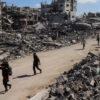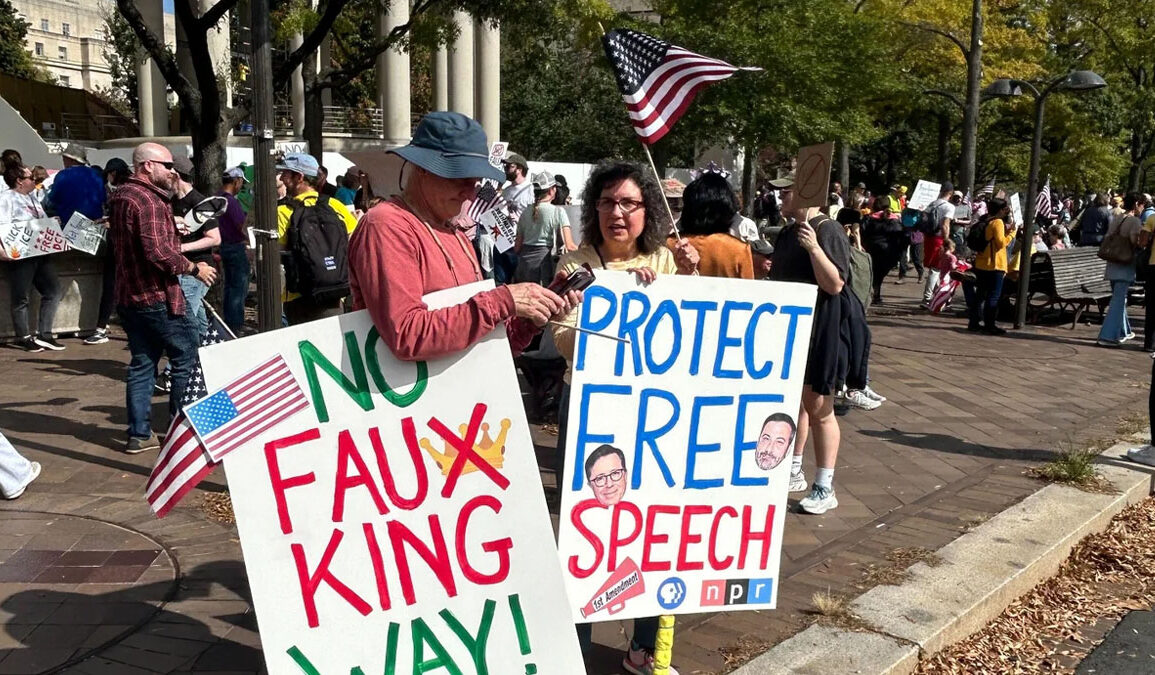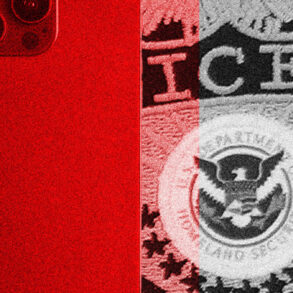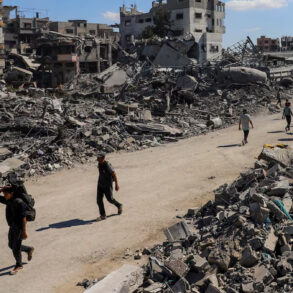No Kings is a branded protest campaign that claims to defend the First Amendment and American democracy from what organizers call President Donald Trump’s abuses of power. Their public message says America has no thrones, no crowns, and no kings. Their website language argues the president believes his rule is absolute and promises that participants will not back down against chaos, corruption, and cruelty. They seem to forget that Trump was democratically elected by the American people.
The second national No Kings day unfolded on Saturday, Oct. 18, 2025. Organizers and outlets cited more than 2,500 to 2,700 events across all 50 states, with images and accounts from major cities like New York, Washington, Chicago, Austin, and from overseas in places such as Malmö, Berlin, and Madrid. Reporters described huge crowds from Los Angeles to New York and smaller marches in towns like Bozeman and Ann Arbor.
Scale was the story. Politico previewed about 2,600 events. NBC reported that organizers claimed nearly 7 million people attended more than 2,700 rallies, which they said topped the first round in June that drew an estimated 5 million across more than 2,100 sites. The New York Police Department said more than 100,000 people demonstrated across the five boroughs and reported zero protest-related arrests.
Why the Protests?
Supporters framed the day as patriotic. The core message targeted what they called authoritarian behavior, including immigration crackdowns and National Guard deployments. Many linked their presence to civil rights, women’s and LGBTQ rights, health care, and free speech. In Washington, Bill Nye urged the crowd with “No thrones! No crowns! No kings!” and accused the administration of rejecting “basic scientific facts.” Sen. Elizabeth Warren told Boston that peaceful mass protest is “deeply American. That is patriotism.” Sen. Bernie Sanders blasted “the billionaire class” and said those backers saw “huge increases in their wealth and power” since Trump took office.
On the streets, participants spoke in moral language. A man in Times Square identified as Ed said, “Because I’m an American, and I learned from history… we’re going down a slippery slope… If we don’t stand up and protest… we’ll be just another one of what Trump called the s—hole countries.” Another man, Brad, said, “We have a fascist government in America abetted by a fascist media.” A woman named Nicole tied her attendance to health care fears. “We can bomb random boats off the coast of Venezuela… spend all this money on ICE terrorizing people… It’s disgusting.” A first-time protester in Washington said she came out of “extreme frustration.” Others talked about “democracy” being at stake and said they did not recognize the country anymore.
Republican leaders rejected the movement and its branding. Speaker Mike Johnson called it a “hate America” rally and predicted he would see “Hamas supporters” and “antifa types” alongside “the Marxists.” The White House economic adviser Kevin Hassett said the protests proved their own contradiction because “everyone’s letting them protest,” which in his view shows there is “no king.” President Trump said, “I’m not a king,” and the White House responded to questions about the rallies with, “Who cares?”
Governors and police announced security measures. New York emphasized peaceful assembly with zero tolerance for lawbreaking. In Virginia and Texas, officials activated Guard support or troopers. In Chicago, organizers said ICE was “occupying our city,” and critics replied that federal officers were carrying out lawful orders.
Not completely violence free
Most mainline rallies were peaceful. New York reported zero protest arrests. Chicago police said there were no arrests at the city’s No Kings march. There were flashpoints away from the core events. In Broadview, Illinois, four people were arrested near an ICE facility at a protest that was not part of No Kings. In Portland, the daytime “No Kings 2.0” rallies were calm, but a smaller evening crowd gathered at the ICE building and federal officers used tear gas, pepper balls, and flash bangs to clear access. Photographs showed people coughing through thick gas and several injured, while the larger daytime gatherings crossed bridges and filled parks without serious conflict.
Coverage was heavy and constant. NBC ran a live blog with on the ground reports from Washington, Austin, Chicago, and other cities, plus photo galleries. Politico’s Playbook led the morning with a preview of events in all 50 states and talked about a strategy to “retake the flag.” Fox News interviewed participants in Times Square and quoted administration figures and critics. HuffPost showcased photos nationwide. USA Today explained the movement’s aims and pointed readers to location finders. Regional outlets like OPB described a peaceful day across Oregon that ended with a show of force at the Portland ICE facility.
What supporters claim vs. what the machine built
Supporters say they are standing up for the Constitution and basic rights. They describe the protests as a patriotic defense of democracy. They insist it is a “peaceful movement” and point to handmade signs as proof of grassroots energy. Organizers Ezra Levin and Leah Greenberg said, “Today, millions of Americans stood together to reject authoritarianism,” and called the day the largest single day of nationwide demonstrations in U.S. history.
But the funding and coordination reveal a different picture. The campaign is powered by a sprawling nonprofit and union network. Accounts tied to the coalition describe 200 to 265 groups, including 501(c)(3) charities, 501(c)(4) political nonprofits, and labor unions, sharing toolkits that call on participants to “stand against the Trump administration” and “fight Trump’s authoritarian takeover.” At the center sits George Soros’s Open Society Foundations. Soros has given more than 32 billion dollars to OSF. The Open Society Action Fund awarded 3 million dollars to Indivisible, a primary No Kings organizer, as part of roughly 7.6 million dollars directed into the organizing infrastructure. Leah Greenberg previously worked for Tom Perriello, who later led OSF, which shows how leadership and money overlap.
Critics say this is a shadow political machine disguised as charity. Jennica Pounds argued the network is “an empire of tax-exempt organizations doing the Democratic Party’s work on the taxpayer’s dime,” using outrage on immigration and Israel to “rage-bait America.” The coalition also integrated a “Palestine Contingent” and labor factions like “UAW Labor for Palestine,” ensuring anti-Israel slogans and speakers appeared inside No Kings events. From this perspective, the movement takes a broad banner like No Kings and fills it with anti-American and socialist messaging that has little to do with constitutional limits and everything to do with power.
Trump allies want transparency and accountability. The president called for investigations into the funding network and told the Justice Department to examine potential RICO issues. Sen. Ted Cruz said Republicans are committed to countering a network of left wing violence. Speaker Johnson warned that these rallies are designed to demoralize the nation and undermine unity.
————
People have the right to protest. That is not in dispute. The Oct. 18 protests were massive, mostly peaceful, and heavily covered. Supporters used patriotic symbols to frame their cause. Critics saw a coordinated spectacle, scripted by professionals and financed by Soros aligned groups that push anti American and socialist narratives. When you pull back from the handmade signs and the costumes, the numbers and the grants tell the clearer story. A billionaire funded web of nonprofits and unions designed the day, set the talking points, and used millions of people as messengers. That is why, even while acknowledging their rights, many Americans see a movement that looks less like citizen action and more like a stage show. In that sense, the slogan says No Kings, but the strings point to one throne that sits far from the ballot box.








